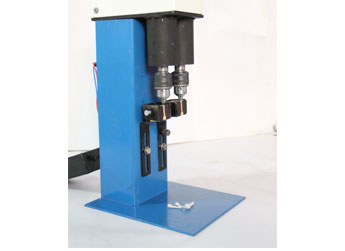Problem addressed:
Machines for making long cotton wick are available in the market for industries; however there is no machine available for making round cotton wick for small scale production or for cottage industries. Conventionally, it is being made manually as a household activity by women in rural and urban areas during their spare time to generate additional income to support their family. The local traders provide raw cotton and buy back cotton wicks from the women giving them compensation in the range Rs. 60 – Rs. 300 per kg, depending upon the size, shape and quality of the wicks.
Product :
Innovators have developed a machine to automate the process of making round cotton wicks, which has achieved production of 20 - 25 wicks/min and fetches highest quality of round cotton wick compared to manual process by which one can make only 8 - 10 wicks per minute. It increases the production efficiency of users by 150%. By adopting this machine, one can easily earn Rs. 100 to Rs 250 per day.
Scout: GIAN West
Cotton wicks for diyas are mostly made by women using their hands manually. Though machines for making long cotton wicks are available however, there is no machine available for making cotton wicks with bulbous base. The innovators have developed a machine to automate the process of making round cotton wicks.
Background
Genesis
As a teenager, Dipakbhai saw a person selling cotton wicks on his bicycle. He inquired about the prospects of the business and availability of raw materials. He got interested and purchased the raw material from the market, made some wicks and sold them. This he did for a few days and then realised alone he would not be able to earn much money. He then went from door to door inquiring with ladies if they wanted to earn some income by making wicks from the raw material provided by him. Many of them agreed and he thus expanded his business. However, many other traders engaged the women trained by him by offering higher rates. Dipakbhai returned to his village and trained ladies there in cotton wick making. He used to fill the cotton wick packets in a gunny bag and bring to the city for selling. He identified many wholesale and retailers for selling his wicks. He also moved around on a bicycle selling them himself. To explore possibilities of business he went to nearby states Rajasthan and Madhya Pradesh as well.
With time he realised that there was only one kind of cotton wick being sold in the market, the long ones. He started trying to make wicks in different shapes and sizes for different use. Once successful, he trained the women working with him as well. When his business became successful, he started exploring ways to scale up. Being a trader, he realized the supply constraint in a highly demand driven market. He further observed that this mismatch existed due to unavailability of machines for making round cotton wicks unlike the once available for long cotton wick.He realised that instead of manually making the wicks, if one could use a machine, it would improve productivity. This will help women earn more money for their effort and reduce the drudgery in the process as well. But he did not have any idea about making the machine.
He shared his concern with his friend Vijaybhai, whose creative mind instinctively accepted this opportunity as a challenge. He left his job and started to dedicate his time working on the machine. Since he had given up his job, Dipakbhai started giving him sustenance allowance so that he could indulge in research for the machine. Both started work on the cotton wick making machine. While Vijaybhai continued his research during the day, Dipakbhai went around selling the cotton wicks. In the night both of them used to sit together to discuss the progress and way forward.
However, even after multiple efforts they failed to develop even the basic mechanism. Once going to work on a rainy day in an auto, Vijaybhai noticed the wiper on its windshield. It struck to him that the same mechanism could be incorporated in their machine. The idea progressed by finance was the other issue. With not much available with them, they had to borrow money on high interest rates from lenders. The lack of mentoring and limited resources delayed the process of development for almost four years with expenses mounting to almost five lakh. They mention that during the phase of development they used to put up their 100 per cent effort with the output only being 10 per cent, which was very frustrating. In 2012, struggling to get resources, both of them had almost given up their project and stopped working on the innovation. Uncertainty of the demand in his tiffin service also forced Vijaybhai to return to his native place. It was at this time GIAN West/NIF came into picture and provided them much needed financial, design and other technical inputs, mentoring and moral support to move ahead with further work.
Patent Applied for (3799/MUM/2013 )
Model 1:
- Productivity/Output per minute: 20-25 units per minute compared to 8-10 units with conventional method
- Power Consumption- 50 Watt
Model 2:
- Productivity/Output per minute: 40-55 units per minute compared to 8-10 units with conventional method
- Power Consumption- 50 Watt
- Compact, portable & affordable.
- Easy to use and maintain.
- Provides income generation opportunity for rural and urban people.
- Very good technology based livelihood generation option for SHGs.








